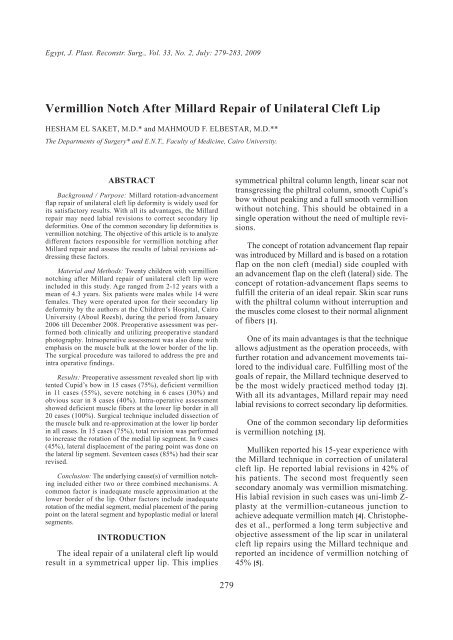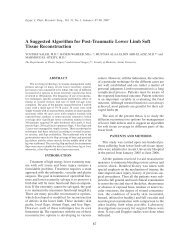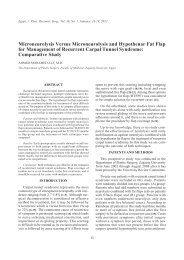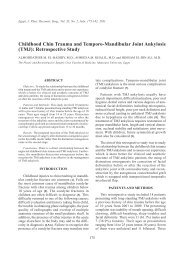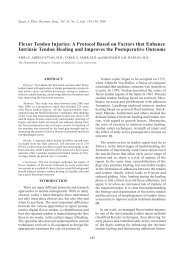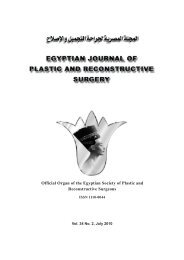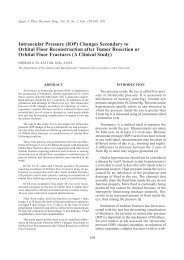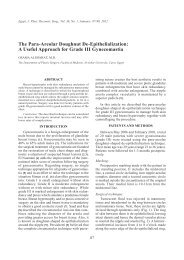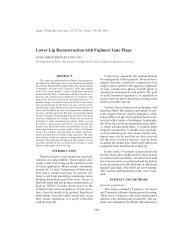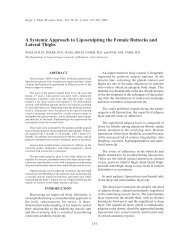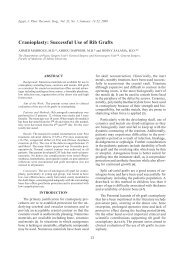Vermillion Notch After Millard Repair of Unilateral Cleft Lip - ESPRS
Vermillion Notch After Millard Repair of Unilateral Cleft Lip - ESPRS
Vermillion Notch After Millard Repair of Unilateral Cleft Lip - ESPRS
Create successful ePaper yourself
Turn your PDF publications into a flip-book with our unique Google optimized e-Paper software.
Egypt, J. Plast. Reconstr. Surg., Vol. 33, No. 2, July: 279-283, 2009<br />
<strong>Vermillion</strong> <strong>Notch</strong> <strong>After</strong> <strong>Millard</strong> <strong>Repair</strong> <strong>of</strong> <strong>Unilateral</strong> <strong>Cleft</strong> <strong>Lip</strong><br />
HESHAM EL SAKET, M.D.* and MAHMOUD F. ELBESTAR, M.D.**<br />
The Departments <strong>of</strong> Surgery* and E.N.T., Faculty <strong>of</strong> Medicine, Cairo University.<br />
ABSTRACT<br />
Background / Purpose: <strong>Millard</strong> rotation-advancement<br />
flap repair <strong>of</strong> unilateral cleft lip deformity is widely used for<br />
its satisfactory results. With all its advantages, the <strong>Millard</strong><br />
repair may need labial revisions to correct secondary lip<br />
deformities. One <strong>of</strong> the common secondary lip deformities is<br />
vermillion notching. The objective <strong>of</strong> this article is to analyze<br />
different factors responsible for vermillion notching after<br />
<strong>Millard</strong> repair and assess the results <strong>of</strong> labial revisions addressing<br />
these factors.<br />
Material and Methods: Twenty children with vermillion<br />
notching after <strong>Millard</strong> repair <strong>of</strong> unilateral cleft lip were<br />
included in this study. Age ranged from 2-12 years with a<br />
mean <strong>of</strong> 4.3 years. Six patients were males while 14 were<br />
females. They were operated upon for their secondary lip<br />
deformity by the authors at the Children’s Hospital, Cairo<br />
University (Aboul Reesh), during the period from January<br />
2006 till December 2008. Preoperative assessment was performed<br />
both clinically and utilizing preoperative standard<br />
photography. Intraoperative assessment was also done with<br />
emphasis on the muscle bulk at the lower border <strong>of</strong> the lip.<br />
The surgical procedure was tailored to address the pre and<br />
intra operative findings.<br />
Results: Preoperative assessment revealed short lip with<br />
tented Cupid’s bow in 15 cases (75%), deficient vermillion<br />
in 11 cases (55%), severe notching in 6 cases (30%) and<br />
obvious scar in 8 cases (40%). Intra-operative assessment<br />
showed deficient muscle fibers at the lower lip border in all<br />
20 cases (100%). Surgical technique included dissection <strong>of</strong><br />
the muscle bulk and re-approximation at the lower lip border<br />
in all cases. In 15 cases (75%), total revision was performed<br />
to increase the rotation <strong>of</strong> the medial lip segment. In 9 cases<br />
(45%), lateral displacement <strong>of</strong> the paring point was done on<br />
the lateral lip segment. Seventeen cases (85%) had their scar<br />
revised.<br />
Conclusion: The underlying cause(s) <strong>of</strong> vermillion notching<br />
included either two or three combined mechanisms. A<br />
common factor is inadequate muscle approximation at the<br />
lower border <strong>of</strong> the lip. Other factors include inadequate<br />
rotation <strong>of</strong> the medial segment, medial placement <strong>of</strong> the paring<br />
point on the lateral segment and hypoplastic medial or lateral<br />
segments.<br />
INTRODUCTION<br />
The ideal repair <strong>of</strong> a unilateral cleft lip would<br />
result in a symmetrical upper lip. This implies<br />
279<br />
symmetrical philtral column length, linear scar not<br />
transgressing the philtral column, smooth Cupid’s<br />
bow without peaking and a full smooth vermillion<br />
without notching. This should be obtained in a<br />
single operation without the need <strong>of</strong> multiple revisions.<br />
The concept <strong>of</strong> rotation advancement flap repair<br />
was introduced by <strong>Millard</strong> and is based on a rotation<br />
flap on the non cleft (medial) side coupled with<br />
an advancement flap on the cleft (lateral) side. The<br />
concept <strong>of</strong> rotation-advancement flaps seems to<br />
fulfill the criteria <strong>of</strong> an ideal repair. Skin scar runs<br />
with the philtral column without interruption and<br />
the muscles come closest to their normal alignment<br />
<strong>of</strong> fibers [1].<br />
One <strong>of</strong> its main advantages is that the technique<br />
allows adjustment as the operation proceeds, with<br />
further rotation and advancement movements tailored<br />
to the individual care. Fulfilling most <strong>of</strong> the<br />
goals <strong>of</strong> repair, the <strong>Millard</strong> technique deserved to<br />
be the most widely practiced method today [2].<br />
With all its advantages, <strong>Millard</strong> repair may need<br />
labial revisions to correct secondary lip deformities.<br />
One <strong>of</strong> the common secondary lip deformities<br />
is vermillion notching [3].<br />
Mulliken reported his 15-year experience with<br />
the <strong>Millard</strong> technique in correction <strong>of</strong> unilateral<br />
cleft lip. He reported labial revisions in 42% <strong>of</strong><br />
his patients. The second most frequently seen<br />
secondary anomaly was vermillion mismatching.<br />
His labial revision in such cases was uni-limb Zplasty<br />
at the vermillion-cutaneous junction to<br />
achieve adequate vermillion match [4]. Christophedes<br />
et al., performed a long term subjective and<br />
objective assessment <strong>of</strong> the lip scar in unilateral<br />
cleft lip repairs using the <strong>Millard</strong> technique and<br />
reported an incidence <strong>of</strong> vermillion notching <strong>of</strong><br />
45% [5].
280 Vol. 33, No. 2 / <strong>Vermillion</strong> <strong>Notch</strong> <strong>After</strong> <strong>Millard</strong> <strong>Repair</strong> <strong>of</strong> <strong>Unilateral</strong> <strong>Cleft</strong> <strong>Lip</strong><br />
The objective <strong>of</strong> this article is to analyze different<br />
factors responsible for vermillion notching<br />
and assess the results <strong>of</strong> labial revisions addressing<br />
these factors.<br />
MATERIAL AND METHODS<br />
Twenty children with vermillion notching after<br />
<strong>Millard</strong> repair <strong>of</strong> unilateral cleft lip were included<br />
in this study. Age <strong>of</strong> the patients ranged from 2-<br />
12 years with a mean <strong>of</strong> 4.3 years. Six patients<br />
were males while 14 were females. They were<br />
operated upon for their secondary lip deformity<br />
by the authors at the Children’s Hospital, Cairo<br />
University (Aboul Reesh), during the period from<br />
January 2006 till December 2008.<br />
All patients had had their previous lip repair<br />
performed using the classic <strong>Millard</strong> rotationadvancement<br />
flap technique. Preoperative assessment<br />
was performed clinically together with preoperative<br />
standard photography. Assessment included<br />
lip length as compared to the non-cleft side<br />
(short/equal), integrity <strong>of</strong> Cupid’s bow (smooth/<br />
tented), vermillion fullness on either side <strong>of</strong> the<br />
notch (near normal fullness/deficient), the severity<br />
<strong>of</strong> the notch (mild/severe) and the quality <strong>of</strong> the<br />
scar (masked/obvious) (Table 1).<br />
Table (1): Results <strong>of</strong> preoperative assessment.<br />
Item<br />
Short <strong>Lip</strong><br />
Tented Cupid’s Bow<br />
Deficient <strong>Vermillion</strong><br />
Severe <strong>Notch</strong>ing<br />
Obvious Scar<br />
Number<br />
Percentage<br />
All corrective procedures were performed under<br />
general anesthesia. The technique was tailored<br />
according to pre and intra-operative findings. Intraoperative<br />
assessment included the bulk <strong>of</strong> muscle<br />
fibers at the lower lip margin. Surgical techniques<br />
used included muscle re-approximation, revision<br />
<strong>of</strong> medial segment rotation and modification <strong>of</strong><br />
the paring point on the lateral lip segment. Scar<br />
revision was done in cases with obvious scars.<br />
Patients were followed-up weekly during the<br />
first month, then monthly thereafter. Postoperative<br />
assessment using both clinical and photographic<br />
documentation was performed after a minimal <strong>of</strong><br />
15<br />
15<br />
11<br />
6<br />
8<br />
75<br />
75<br />
55<br />
30<br />
40<br />
3 months <strong>of</strong> corrective surgery. Follow-up period<br />
ranged from 3 to 34 months with a median <strong>of</strong> 16<br />
months.<br />
RESULTS<br />
Preoperative assessment revealed short lip with<br />
tented Cupid’s bow in 15 cases (75%), deficient<br />
vermillion in 11 cases (55%), severe notching in<br />
6 cases (30%) and obvious scar in 8 cases (40%)<br />
(Table 1). Intra-operative assessment showed deficient<br />
muscle fibers at the lower lip border in all<br />
20 cases (100%) (Fig. 1). Patients with deficient<br />
vermillion (n=11) included two different groups,<br />
those with hypoplastic medial segments (n=2) and<br />
those with medially placed paring point on the<br />
lateral lip segment (n=9). This latter group retained<br />
cleft tissue in their previous repairs that accounted<br />
for the hypoplastic appearance <strong>of</strong> the vermillion<br />
at the site <strong>of</strong> notching.<br />
Surgical technique included dissection <strong>of</strong> the<br />
muscle bulk and re-approximation at the lower lip<br />
border in all cases. In 15 cases (75%), total revision<br />
was performed to increase the rotation <strong>of</strong> the medial<br />
lip segment. Back cuts were used in these cases to<br />
gain enough length. In 9 cases (45%), lateral displacement<br />
<strong>of</strong> the paring point was done on the<br />
lateral lip segment with excision <strong>of</strong> excess cleft<br />
tissue available at the lateral aspect <strong>of</strong> the vermillion<br />
notch (Fig. 2). Too medial placement <strong>of</strong> the paring<br />
point was the only case in 5 cases, while 4 cases<br />
had both inadequate rotation in addition to lateral<br />
paring point displacement. These 4 cases therefore<br />
needed total lip revision to improve rotation <strong>of</strong> the<br />
medial segment, in addition to lateral displacement<br />
<strong>of</strong> the paring point on the lateral segment. Although<br />
the old scar was obvious only in 8 cases, however,<br />
a total <strong>of</strong> 17 cases (85%) had their scar revised.<br />
Those included the 15 total lip revisions in addition<br />
to 2 cases with obvious scars that did not need<br />
total revision (Table 2).<br />
Table (2): Surgical techniques.<br />
Technique<br />
Re-approximation <strong>of</strong> muscle at the<br />
lower lip margin<br />
Total <strong>Lip</strong> Revision with adequate<br />
rotation <strong>of</strong> the medial segment<br />
Lateral Displacement <strong>of</strong> the paring<br />
point on the lateral segment<br />
Scar revision (including total lip<br />
revisions)<br />
Number<br />
20<br />
15<br />
9<br />
17<br />
Percentage<br />
100<br />
75<br />
45<br />
85
Egypt, J. Plast. Reconstr. Surg., July 2009 281<br />
Accordingly, the underlying cause(s) <strong>of</strong> vermillion<br />
notching included either two or three combined<br />
mechanisms. Inadequate muscle approximation is<br />
a common factor in all cases. The second cause<br />
was inadequate rotation <strong>of</strong> the medial segment<br />
(n=9) and medial placement <strong>of</strong> the paring point on<br />
the lateral segment (n=5). Four patients had combined<br />
both inadequate rotation and medially placed<br />
paring point. Another 2 patients combined inadequate<br />
rotation with hypoplastic medial segments<br />
(Table 3).<br />
Table (3): Combination <strong>of</strong> factors in vermillion notching.<br />
Factors<br />
Inadequate muscle bulk +<br />
Inadequate rotation <strong>of</strong> the medial<br />
segment<br />
Inadequate muscle bulk + Medially<br />
placed paring point on the lateral<br />
segment<br />
Inadequate muscle bulk +<br />
Inadequate rotation <strong>of</strong> the medial<br />
segment + Medially placed paring<br />
point on the lateral segment<br />
Inadequate muscle bulk +<br />
Inadequate rotation <strong>of</strong> the medial<br />
segment + Hypoplastic medial<br />
segment<br />
Total<br />
Number<br />
Percentage<br />
Fig. (2): Using the <strong>Millard</strong> technique in correction <strong>of</strong><br />
unilateral cleft lip deformity, the paring point that determines<br />
where the lateral lip segment meets with its counterpart<br />
on the medial segment is determined by several<br />
methods. The dotted line (a) refers to this paring point as<br />
the point where the white roll attenuates, which is usually<br />
at a distance from the oral commissure equal to its counterpart<br />
on the normal side. The dotted line (b) refers to a<br />
more favorable point, placed slightly laterally, marked by<br />
the level <strong>of</strong> maximal vermillion fullness.<br />
9<br />
5<br />
4<br />
2<br />
20<br />
45<br />
25<br />
20<br />
10<br />
100<br />
All patients tolerated the procedures well with<br />
no significant intra-operative medical or surgical<br />
complications. Wound infection was noted only in<br />
one case (5%) and was managed conservatively.<br />
Postoperative assessment showed satisfactory results<br />
in 18 cases (90%) (Fig. 3), while residual<br />
notching was noted in 2 cases (10%). Cases with<br />
residual notching were those who showed inadequate<br />
rotation <strong>of</strong> the medial segment together with<br />
hypoplastic medial segment.<br />
Fig. (1): Intraoperative photograph showing deficient<br />
muscle bulk at the lower lip border. Note the edge <strong>of</strong> the<br />
repaired muscle in the upper half <strong>of</strong> the lip, while the lower<br />
half is totally deficient <strong>of</strong> muscle bulk.<br />
Fig. (3): Pre operative (left) and post operative (right)<br />
photographs <strong>of</strong> a patient with vermillion notching after <strong>Millard</strong><br />
<strong>Repair</strong> <strong>of</strong> left unilateral cleft lip. The causes <strong>of</strong> notching in this<br />
case included: deficient muscle approximation at the lower lip<br />
border, inadequate rotation <strong>of</strong> the medial flap and medially<br />
placed paring point on the lateral flap. Correction was performed<br />
by total lip revision, muscle approximation at the lower border,<br />
increasing medial segment advancement with a back cut and<br />
excision <strong>of</strong> cleft tissue from the lateral flap with medial placement<br />
<strong>of</strong> the paring point at the point <strong>of</strong> maximal vermillion fullness.
282 Vol. 33, No. 2 / <strong>Vermillion</strong> <strong>Notch</strong> <strong>After</strong> <strong>Millard</strong> <strong>Repair</strong> <strong>of</strong> <strong>Unilateral</strong> <strong>Cleft</strong> <strong>Lip</strong><br />
DISCUSSION<br />
A smooth balanced vermillion is the resultant<br />
<strong>of</strong> a perfect match between the medial and lateral<br />
segments. <strong>Vermillion</strong> notching represents an element<br />
<strong>of</strong> mismatch between the two segments. The<br />
problem <strong>of</strong> vermillion mismatching may result<br />
from indolent factors in the cleft lip, surgical factors<br />
related to the technique used or a combination <strong>of</strong><br />
both [4].<br />
By indolent factors, we mean obvious difference<br />
in bulk between the medial and lateral lip<br />
segments caused by the mechanism <strong>of</strong> clefting and<br />
in particular the oblique muscle orientation. While<br />
some surgeons described a hypoplastic medial lip<br />
segment, others stated the opposite. Mulliken<br />
reported his 15-year experience with the <strong>Millard</strong><br />
technique in correction <strong>of</strong> unilateral cleft lip. He<br />
stated that the most common secondary labial<br />
problem was fullness <strong>of</strong> the lateral mucosal border<br />
and minor deficiency <strong>of</strong> the median tubercle. He<br />
also mentioned that although this imbalance could<br />
be addressed primarily, it is probably best corrected<br />
secondarily. This is accomplished by rotation <strong>of</strong><br />
a de-epithelialized submucosal flap into the tubercle<br />
[4]. The same principle <strong>of</strong> hypoplastic medial<br />
segment was described by Noordh<strong>of</strong>f. However,<br />
he advocated the use <strong>of</strong> a triangular vermillion<br />
flap devised from the redundant vermillion on the<br />
lateral side to compensate for its deficient counterpart<br />
on the medial side [6]. In this study group,<br />
only 2 patients had evident hypoplastic medial<br />
segments.<br />
On the other hand, <strong>Millard</strong> stated that many <strong>of</strong><br />
his patients exhibit the opposite problem. He referred<br />
to attenuation <strong>of</strong> the lateral mucosal free<br />
margin. For this deficiency <strong>of</strong> the lateral mucosa,<br />
he recommends secondary correction with a V-Y<br />
mucosal roll-down flap [1]. In the same line, Lewis<br />
also described the problem as a full medial segment<br />
as opposed to an attenuated lateral segment. However,<br />
he referred to excessive advancement <strong>of</strong> the<br />
lateral flap as a cause <strong>of</strong> the imbalance rather than<br />
indolent factors [7].<br />
Indolent factors can therefore be responsible<br />
for vermillion mismatch. However, surgical factors<br />
can be as much influential. Surgical inadequacy<br />
can be evident in muscle restoration at the lower<br />
part <strong>of</strong> the lip, in medial flap rotation or in lateral<br />
flap advancement. The aberrant, oblique configuration<br />
<strong>of</strong> the orbicularis muscle segments represents<br />
one <strong>of</strong> the most important anatomic abnormalities<br />
in the cleft lip. Correct repositioning <strong>of</strong> the muscle<br />
into a horizontal orientation is critical in repair.<br />
Success on the skin level will never compensate<br />
for deficiencies in muscles redirection [8].<br />
This is particularly applicable to the lower half<br />
<strong>of</strong> the lip, where the obliquity <strong>of</strong> the fibers may<br />
account for its deficiency. Deficiency <strong>of</strong> the muscle<br />
bulk can cause vermillion notching. It is the muscle<br />
bulk on the medial segment that is usually less<br />
than its counterpart on the lateral segment. Adequate<br />
dissection and reorientation <strong>of</strong> the muscle fibers<br />
is crucial in obtaining a matched vermillion [9].<br />
An overdo in muscle approximation has been proposed<br />
by Narayanan, producing a ''roll'' or ''sausage''<br />
bulge at the site <strong>of</strong> muscle repair in order to achieve<br />
enough bulk at the vermillion border capable <strong>of</strong><br />
preventing notching [3]. All cases included in this<br />
study were found to have inadequate muscle bulk<br />
at the lower border <strong>of</strong> the lip. Muscle dissection<br />
and approximation was a common step in all corrective<br />
procedures (Fig. 1).<br />
Regarding the medial flap, Ray stated that one<br />
<strong>of</strong> the more common errors observed in <strong>Millard</strong>’s<br />
technique is insufficient rotation. He described<br />
several rotation errors that include faults in flap<br />
incision design, failure to utilize a back cut and<br />
failure to orient the muscle fibers. The effect <strong>of</strong><br />
under rotation <strong>of</strong> the medial flap was emphasized<br />
by Narayanan as a definite cause <strong>of</strong> vermillion<br />
notching. In this series, 75% <strong>of</strong> patients had inadequate<br />
rotation <strong>of</strong> the medial segment. Increasing<br />
rotation was achieved by total revision <strong>of</strong> the lip,<br />
with back cuts at the columellar base for more<br />
length.<br />
Retaining effective rotation also depends on<br />
appropriate design and elevation <strong>of</strong> the advancement<br />
flap. A critical determinant is where the<br />
advancement flap is pared (<strong>Millard</strong> point 8). The<br />
classic technique in defining this point depends<br />
on measuring the non cleft vermillion from commissure<br />
to Cupid’s bow peak and imposing this<br />
measurement on the cleft side [1]. Other surgeons<br />
define this point by the point where the white roll<br />
attenuates. Both these techniques put the paring<br />
point too medial on the vermillion-cutaneous junction<br />
<strong>of</strong> the cleft side, with consequent shortening<br />
<strong>of</strong> the lip height and possible notching [10].<br />
Ray recommended using the volume <strong>of</strong> the<br />
vermillion in determining the paring point. It is<br />
the point where the vermillion volume starts to<br />
attenuate that would obtain perfect matching.<br />
Such lateral placement <strong>of</strong> the paring point may<br />
apparently sacrifice too much vermillion on the
Egypt, J. Plast. Reconstr. Surg., July 2009 283<br />
advancement side. However, having enough volume<br />
on the advancement flap produces a better<br />
volume match and consequently less incidence<br />
<strong>of</strong> notching [10].<br />
Sacrificing too much vermillion may compromise<br />
the length <strong>of</strong> the lip segment. To ensure adequate<br />
length, several minor modifications are proposed.<br />
These include extending the tip <strong>of</strong> the<br />
advancement flap into the vestibule, convex design<br />
<strong>of</strong> the advancement flap incision and designing a<br />
white roll flap on the rotation side to be inserted<br />
into the a small incision on the advancement side<br />
at the vermillion-cutaneous junction [8]. The design<br />
<strong>of</strong> incisions and placement <strong>of</strong> points have been<br />
proposed by several surgeons as the most influential<br />
factor in determining success. This applies more<br />
to point 8 on the lateral lip segment. Inclusion <strong>of</strong><br />
''cleft tissue'' in the repair guarantees a secondary<br />
deformity [5,7,11,12]. In this series, 45% had medially<br />
placed paring point on the lateral flap with inclusion<br />
<strong>of</strong> cleft tissue in the repair and consequent notching.<br />
Excision <strong>of</strong> cleft tissue and lateral displacement <strong>of</strong><br />
the paring point achieved excellent results (Fig.<br />
2).<br />
Conclusion:<br />
In conclusion, vermillion notching represents<br />
a common secondary lip deformity following <strong>Millard</strong><br />
repair <strong>of</strong> unilateral cleft lip. Indolent and<br />
surgical factors share in the development <strong>of</strong> this<br />
deformity. Indolent factors in the form <strong>of</strong> tissue<br />
hypoplasia are not preventable and should be augmented<br />
by local flaps. Surgical factors, on the other<br />
hand, can be prevented. Recommendations during<br />
primary repair include adequate muscle alignment<br />
in the lower half <strong>of</strong> the lip, adequate rotation <strong>of</strong><br />
the medial segment and precise definition <strong>of</strong> the<br />
paring point on the advancement flap.<br />
REFERENCES<br />
1- <strong>Millard</strong> D. Jr <strong>Cleft</strong> Craft: The evolution <strong>of</strong> its surgery.<br />
Vol. 1: The unilateral deformity. Boston: Little, Brown,<br />
449-485, 1976.<br />
2- Reddy G., Webb R., Reddy R., et al.: Choice <strong>of</strong> incision<br />
for primary repair <strong>of</strong> unilateral complete cleft lip: A<br />
comparative study <strong>of</strong> outcomes in 796 patients. Plast.<br />
Reconstr. Surg., 121 (3): 932-40, 2008.<br />
3- Narayanan P. and Adenwalla H.: <strong>Notch</strong>-free vermillion<br />
after unilateral cleft lip repair: The Charles Pinto centre<br />
protocol. Indian Journal <strong>of</strong> Plastic Surgery, 41 (2): 167-<br />
170, 2008.<br />
4- Mulliken J. and Martinez-Perez D.: The principle <strong>of</strong><br />
rotation advancement for repair <strong>of</strong> unilateral complete<br />
cleft lip and nasal deformity: Technical variations and<br />
analysis <strong>of</strong> results. Plast. Reconstr. Surg., 104 (5): 1247-<br />
60, 1999.<br />
5- Christ<strong>of</strong>ides E., Potgieter A. and Chait L.: A long term<br />
subjective and objective assessment <strong>of</strong> the scar in unilateral<br />
cleft lip repairs using the <strong>Millard</strong> technique without<br />
revisional surgery. J. Plast. Reconstr. Aesthet. Surg., 59<br />
(4): 380-6, 2006.<br />
6- Norrdho<strong>of</strong>f M.: Reconstruction <strong>of</strong> vermillion in unilateral<br />
and bilateral cleft lips. Plast. Reconstr. Surg., 73: 52,<br />
1984.<br />
7- Lewis M.: <strong>Unilateral</strong> cleft lip repair: Z-plasty. Clin. Plast.<br />
Surg., 20: 647, 1993.<br />
8- Ray R.: <strong>Unilateral</strong> cleft lip repair by rotation/advancement:<br />
potential errors and how to avoid them. Facial Plast. Surg.,<br />
23 (2): 87-90, 2007.<br />
9- Park C. and Ha B.: The importance <strong>of</strong> accurate repair <strong>of</strong><br />
the orbicularis oris muscle in the correction <strong>of</strong> unilateral<br />
cleft lip. Plast. Reconstr. Surg., 96: 780, 1995.<br />
10- Losee J., Selber J., Arkoulakis N., et al.: The cleft lateral<br />
lip element: Do traditional markings result in secondary<br />
deformities? Ann. Plast. Surg., 50 (6): 594-600, 2003.<br />
11- LaRossa D.: <strong>Unilateral</strong> cleft repair. In: Bentz M., Ed.<br />
Pediatric Plastic Surgery. Stamford: Appleton and Lange,<br />
1998.<br />
12- Skoog T.: The <strong>Cleft</strong> lip. In: Skoog T., Ed. Plastic Surgery.<br />
Philadelphia: WB Suadners, 107, 1974.


